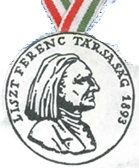György Selmeczi, Camerata Transsylvanica Liszt – Late Works (orchestrated by György Selmeczi)
Liszt’s late piano works arranged, orchestrated and conducted by György Selmeczi.
The CD was awarded with the 28th International "F. Liszt" Record Grand Prix founded by the F. Liszt Society, Budapest.
About the album
Recorded at the Phoenix Studio, Hungary
Recording producer: Ibolya Tóth
Balance engineer: János Bohus
Digital editing: Veronika Vincze, Mária Falvay
Cover photo: Dániel Németh
Inside cover and portrait photos: István Huszti
Design: Meral Yasar
Produced by László Gőz
The recording was sponsored by the Ministry of Cultural Heritage and the National Cultural Fund of Hungary
Reviews
John Warrack - Gramophone (en)
David Hurwitz - ClassicsToday.com - 10/9 (en)
Grant Chu Covell - La Folia (en)
Josep Pascual - CD Compact - recommendado (es)
L.S. - Scherzo (es)
Justino Losada Gómez - Filomusica.com (es)
Tóth Péter - Café Momus (hu)
Ferenc Liszt:
Ferenc Liszt: Quatre valses oubliées
Ferenc Liszt: Hungarian historical portraits
Ferenc Liszt:
Ferenc Liszt, 1885
Secret Communication (Liszt transcripts by György Selmeczi)
According to the recollections of one of his disciples, Ferenc Liszt in his old age, compared himself to a conjurer of fireworks, sending his rockets into the infinite, for a sightless public. The overwhelming majority of his contemporaries misunderstood or were indeed, oblivious to the entire last two decades of his life's work, and, in fact most of his works that were written his old age were not even published. These works did not become a part of contemporary concert life nor did this dreary picture improve during the following century.
This part of Liszt's oeuvre was filled with other problematic musical curiosities. Though great composers, such as Béla Bartók and Arnold Schönberg, or some musicologists, driven by the spirit of experiment, have gazed into the glitter of his fireworks, few and far between are the real messages that have been received and decrypted from the strangest landscapes of 19th century music.
This makes this recording all the more exciting as it implies that signals, sent by a composer into the future, will, of invariably, if unexpectedly, find their addressee. In Gyögy Selmeczi's Liszt arrangements, I sense a connection between the two composers, with stimulus and response spanning the gap of a century. A certain similarity of temperament between the two persons is obvious, as far as their musical activities are concerned. Selmeczi commenced his career as a concert pianist, and later turned with the same enthusiasm to conducting. Having began composing from the very start, he later also founded and managed ensembles. He aspires to have a comprehensive grasp of tremendous fields of music and his is an inquisitive genius.
So much is certainly to be said about the arranger-author, as his character goes to explain what and why he hears in the late piano works of the old Master. In the case of this recording, the aim was definitely to make public an interpretation by a contemporary composer and to elaborate on the hidden contents, concealed behind Liszt's almost sketchy, taciturn scores, rather than to simply arrange the piano pieces for orchestra.
The life of Franz Liszt was beset by paradoxes and contradictions. Next to Paganini, he was undoubtedly the most celebrated performing artist of the 19th century, yet few great composers have been misunderstood in so many ways as he was. Until the age of forty, Liszt strove for the monumental both as performer and as composer, writing enormous uninterrupted series or cycles of protracted pieces in one movement. He was guided in his individual compositions by the idea of perfection, as were his idols, Beethoven, and Wagner with whom he felt closer to than his contemporaries. Liszt was also tempted by the Great Ideal of the morally and culturally perfect human being, the illusion of millions of humanity united in the religion of art. He wished to build, to seize and serve the whole, and when he saw the great schism of the century, the setback for European liberty movements and the warning signs of a new, aggressive, expansive and tyrannical politics, he had to accept with disappointment that, in a human as well as an artistic sense, he had been chasing a delusive dream. The public, entirely seduced by the frenzy of power no longer needed his honest idealism. By the end of the 1850s, Liszt himself realised this, and it is not by chance that Hamlet, Prince of Denmark, a loser and anti-hero who is incapable of making up his mind is the central character of his last Weimar symphonic poem. The later period of the composer Ferenc Liszt can probably be dated from here. Symbolically speaking: after the cracking and disintegration of the integral whole, flowers bloom, by the fault lines holding an occasional pearl in their petals: namely Liszt's biblical oratorios, ecclesiastical pieces, piano pieces in cycles or on their own - intrinsic, intimate, bitter or nostalgic, half-told, half-whispered prayers and monologues. Regarding their musical language, they are strange and modern compositions, and during the past fifty years, have often been seen as the prophetic precursors of the fragmented musical style of the 20th century.
This, incidentally, is the old and often debated dilemma. Why is it that in spite of his oeuvre's poor reception, Liszt's music obviously influenced later composers, especially pianists who knew him personally or studied under one or of his most famous disciples? His influence, however, was by no means stronger than, for example, the influence of Brahms, who was thought at that time to be Liszt's opposite, or in the case of Wagner, who brought his oeuvre to a triumphant completion. The unfinished oeuvre did not encourage continuation any more than the completed ones, and indeed, those seeking their ways in the 20th century preferred to turn to stable, complete periods and composers rather than to representatives of an order out of joint. For this reason, "Zukunftsmusik", or the music of the future as contemporaries were prone to call that which seemed to them too audacious, did not in fact become the music of the future, but remained an artistical monument to its time. "Nevertheless", said György Selmeczi, while re-arranging the later works of Liszt for other instruments, "there is a connection between Liszt and the 20th century". A Secret communication exists, proving some sort of contemporaneousness, in that, the dilemmas Liszt poses as a composer bear similarity with those of his colleagues living many generations later. This is, of course, the view of the historian. The composer experiencing and recognising these similarities or not as the case may be, nevertheless thinks in terms of concrete pieces; chooses and answers according to his calling and inspiration.
The thirteen pieces on this recording were originally written for the piano. During the last years of Liszt's life (1881-1885). The first three forgotten waltzes were published between 1881 and 1884, the Csárdás Obstiné in the year of his death, and the Csárdás macabre after his demise. The Hungarian Historical Portraits series was published seventy years after his death. The waltzes were composed by Liszt not as a cycle, but sporadically, with titles sometimes in French, sometimes in German. The pieces themselves are fragmented, their themes retrieved abruptly and unexpectedly, as if from thin air. It is interesting to note that Liszt considers the waltz of the 1880's to be a relic of a bygone age, while in fact waltzes were the absolute height of fashion in Europe at that time. In fact, Liszt is taking his leave not of the waltz, but through it his youth and the Parisian ballrooms. As if, to use a simile of György Selmeczi, he glimpsed the ball through the narrow window of his monk's cell, catching a segment of the whole view: a bright chandelier, the momentum of dancing feet, a trail, a smile or a sigh.
When listened to attentively, we find in the four forgotten waltzes the quintessential waltz, the very vocabulary of the musical building blocks, the ingenious musical content of the beat and the intricate rhythms underlying the three-four-time signature, fill us with wonder. The musical content of one of these forgotten waltzes would, in itself, be enough for three or four pieces. When played on the piano, one experiences the undoubted enchantment of the composer, languidly searching among his memories. When played by an orchestra, the effect is as though the waltz were viewed from many camera positions simultaneously. The flexible treatment allows a full orchestral effect as well as chamber-like arrangements, and also close-ups whenever the music diminishes into one voice. Ideally, the effect is symphonic, but the performing ensemble, Camerata Transsylvanica is in fact somewhere between a chamber orchestra and a full symphonic one. (The solo ideas of the arrangement were inspired by the quality of the orchestra including leading members of first-rate Budapest orchestras and handpicked musicians invited from Cluj.)
The beat of the first two of the four waltzes is quite different from that of the others. The first is ethereal, pastel-like while the second is more of a marionette-dance, square and hard, almost grotesque. The third and fourth are playful, naive and pastoral at the same time. Orchestration magnifies all this without lessening the integral cyclic effect, and this method of performing the waltzes is original enough to create integrity.
Liszt himself also intended his Hungarian Historical Portraits to form a strongly bound series. We have seven somewhat blurred portraits here, the main gesture being homage rather than a portrait. The series is one of the last completed works of Liszt. A Hungarian pantheon, moulded into music, with effigies of the glorious patriots of 19th century Hungary. These piano pieces strike a mourning tone; they were composed after the people portrayed in them had departed from life. For the sake of the reader unfamiliar with Hungarian history, it might be worthwhile to take a glance at the names: Count István Széchenyi (1791-1860), known as the "greatest Hungarian" financed and built "Lánchíd" the famous Danube suspension bridge, founded the Hungarian Academy of Sciences, was Transport Secretary for the 1848 Revolutionary Government and who finally for political reasons, died by his own hand; Baron József Eötvös (1813-1871), politician and author, Secretary for Education and Religion after the Austro-Hungarian Compromise of 1867; Mihály Vörösmarty (1800-1855), the great poet of Hungarian Romanticism, who wrote a beautiful ode in honour of Liszt after the latter's triumphal Hungarian procession of 1840; Count László Teleki (1811-1861), politician, author (died by his own hand, for political reasons); Ferenc Deák (1803-1876), politician, author, spiritual rector of the 1867 Compromise with the House of the Hapsburg; Sándor Petőfi (1823-1849), poet and revolutionary, a great figure of Hungarian romanticism, and Mihály Mosonyi (1815-1870), composer, and considered after Liszt and Ferenc Erkel to be one 19th Century Hungary's most important composers. Most were of the same generation as Liszt who knew many of them in person and was friendly with one or two of them. In one of his letters, the composer mentions authentic portraits, but what he meant by this is unclear to the listeners today, as the pieces are all very much of a kind (of course, the moustache and beard were almost obligatory for Hungarian men in those days85). The similarity, the pledge of the coherence of this series is repeated as a motto preceding each piece, a trumpet-like motive, descending a fourth or a fifth. The Hungarian stylistic stratum is also shared by these pieces: the essence of Liszt's earlier artistic style, the best, and most representative examples of which, are his Hungarian Rhapsodies. But while the Hungarian Rhapsodies use folk motives or similar tunes, the Historical Portraits hardly contain any foreign material, and the typical Hungarian musical turns are integrated into the composition as musical building blocks. The heart of the matter is in the system of sounds and rhythm, the former with its peculiarly coloured harmonies and the latter conjuring up many themes reminiscent of two-beat marches and dances.
That the manuscript is a draft is perhaps felt more in this cycle than in any other work composed towards the end of Liszt life. The few instructions as to orchestration in the original manuscript and the fact that Arthur Friedheim, one of Liszt's disciples, did in fact orchestrate a few of the movements while Liszt was still alive, imply that Liszt probably intended to compose an orchestral piece. Thus György Selmeczi expresses these latent orchestral qualities, with great effect, using the shocks and contrasts of a frequently changing orchestral mass. Perhaps the spell cast over these significant but ill-fated pieces will be broken by just this congenial arrangement, and the Historical Portraits will move from the edges of the musical domain towards its centre.
The two, perhaps best-known works of the elderly Liszt complete this recording: the Csárdás macabre and Csárdás Obstiné. In the latter particularly, Liszt reached the uttermost limits of what the audience of his time were capable of appreciating. As far as the themes are concerned, he creates them from next to nothing, his tones and harmonies seem vacant when compared with the harmonic world of his more romantic creations, and the inimitable repetitions led many to believe for decades after Liszt's death that these obsessive pieces in fact documented the exhaustion and drying-up of his creative talents. The truth is that this is the demonical, sarcastic force that had always formed part of Liszt's personality, now freed of its fetters, in this great fresco-like Dance Macabre vision for piano and orchestra, in which the seer recalls the Medieval symbol, a skeleton playing the fiddle to all and sundry. To include this in the style of a csárdás, the only exportable 19th century Hungarian dance, shows a deepening emotional relationship between Liszt and his country.
The two dances are astonishing on the piano, especially on the piano of Liszt that had been the source of so much pleasure. Rare is the music that represents the tragedy of the age more starkly. The orchestral version partly enhances the Hungarian character of the pieces with effects alluding to Gypsy Music, and increases their bizarre effect partly by using extremely high or deep registers. We have to admit that extravagance is a much-loved artistic attitude now, at the start of the 21st century. Could it be that Ferenc Liszt is to find his true contemporaries in the century now upon us?
András Batta
György Selmeczi - composer, conductor, pianist
Born in 1952 in Cluj, he began his studies at the age of five, and subsequently continued in Bucharest, Budapest and Paris. He is one of the most fascinating personalities of Hungarian music life, a versatile, all-round musician who is at home and active in almost every musical field.
On completion of his studies he worked in various theatres as musical director, conductor or chief conductor. He has composed music for the both theatre and cinema. He founded and directed the New Music Studio of Miskolc, the Camerata Transsylvanica, the Budapest Chamber Opera, the Measure Association and the Auris Society. He has participated in the opening performances of hundreds of contemporary pieces both as a conductor and as a pianist. In recent years the operatic field has become the centre of his attention. He has served as permanent guest conductor of the Hungarian Opera of Cluj since 1990, and as Opera Director since 1994.
He has given concerts all over Europe, has recorded several albums and made a number of musical series for TV. He has twice won the Best Film Music Award, and the Artisjus Award for the presentation of new pieces three times. He is an Erkel Prize winner.
Major works: The Siren, Spiritualists – opera; Prince Nutcracker – musical; I am Schweik, The Three Musketeers – musical; The Children of the Motherland – ballet, The Tisza – oratorio; Requiem; Three pieces for orchestra; Two pieces for orchestra; Cantici da chiesa – ten solo cantatas; Sanctuarium – cantata cycle; five masses; four string quartets; choir pieces; piano pieces; songs.


